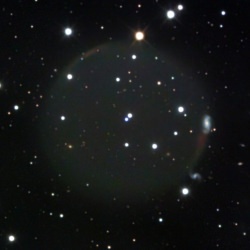
Abell 34 by Jim Misti
Most stars do not end their existence in a cataclysmic supernova explosion. For example, our Sun is more typical and someday, in the remote future, the location of our local star will look something like this picture of a distant planetary nebula.
Suns are born from vast clouds of dust and gas that gather in the dark places between the stars. Gravity causes these interstellar vapors to collapse inward until the pressure causes high enough temperatures at its center to fuse hydrogen, the universe’s basic building block, into helium – an event that also releases gamma-ray photons. These photons can take a million years to travel outward through the overlying matter until they reach the surface and escape into space as visible light. The push of the photon’s rush to make an exit also stops the cloud’s collapse and thus what began as thin gas and dust becomes a shining star illuminating the heavens. For billions of years stars, similar to our sun, shine predictably until the hydrogen starts to give out. Then through a series of steps, helium is fused into a succession of elements and the star expands enormously; eventually throwing off its outer surface like a spherical shell. This ends the star’s previous life and marks its passing with a ghostly shroud known as a planetary nebula.
George Abell was a professor at UCLA and an admired research astronomer who began is career as a tour guide at the Griffith Observatory in Los Angeles. As an astronomer, he was best known for his work at Mt. Palomar with the first photographic sky survey conducted in the 1950’s. He cataloged galaxy clusters and contributed to our understanding of their formation and evolution. He also compiled a catalog of 86 faint planetary nebulas discovered as he studied the sky plates taken with Palomar’s 48 inch Oschin Schmidt Telescope.
This planetary nebula is number 34 in Abell’s listing and is located in the constellation of Hydra. It is very faint and has a low surface brightness thus making it very hard to see or photograph, even with a large telescope.
Astronomer Jim Misti produced this exceptional image over three nights in February 2006 using his personal 32-inch telescope located in a dark remote spot in Arizona. The light grasp of Jim’s instrument is several thousand times greater than the unaided eye yet the faintness of this nebula still required over four hours of accumulated exposure time to take this full color picture. Notice, also, the small galaxies located much farther in the distance.
Do you have photos you’d like to share? Post them to the Universe Today astrophotography forum or email them, and we might feature one in Universe Today.
Written by R. Jay GaBany
